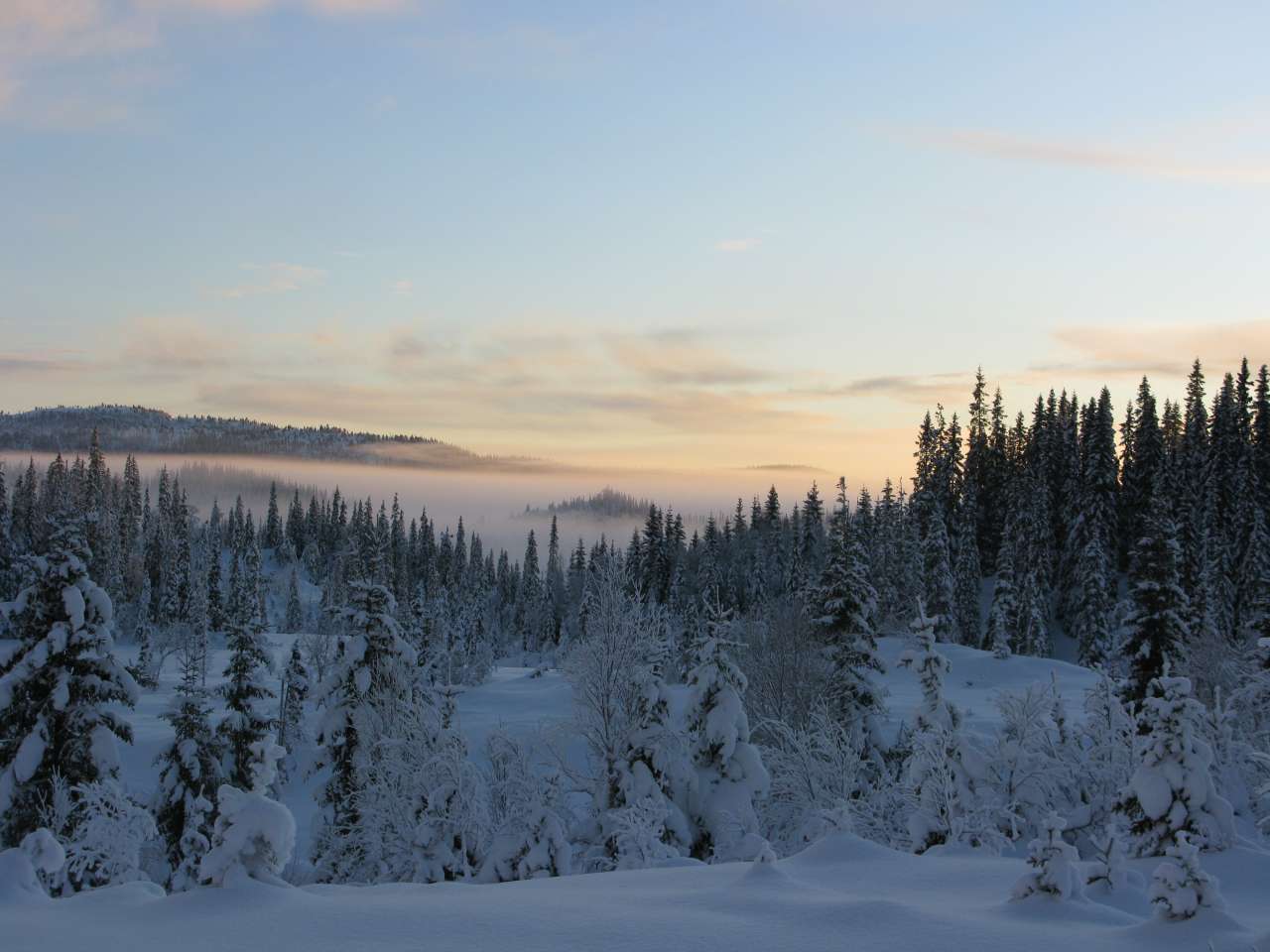Forests and climate: learning from the past to predict the future

If the forest is dense and evenly aged, snowfall is retained in the tree crowns. Some of it does not reach the ground at all but is returned to the atmosphere as water vapour. This results in less runoff during snow melt and reduces the flood volume in spring. But if the forest is less densely planted, and perhaps not even aged, more of the snow will reach the ground and might lead to higher flood peaks during melt. Photo: Arne Steffenrem/NIBIO.
Climate change is a global societal challenge. In order to prioritize mitigation and adaption options in the forest sector, increased knowledge about how forests affect climate and how climate affects forest is necessary. A new international research project, led by NIBIO, aims to fill this knowledge gap.
IMPRINT is the name of a brand new, NOK 10 million, three-year research project granted by the Norwegian Research Council in order to study the interactions between forests, forest management and climate in Norway.
The project is a collaboration between NIBIO and the Norwegian Water Resources and Energy Directorate (NVE), and involves international experts from Sweden, UK and the US.
NIBIO scientist and project manager Stephanie Eisner explains how the IMPRINT project aims to bridge past data on forest growth and management with predictions about how the future forests will affect climate, and also how a future climate will affect our forests.
- Anthropogenic greenhouse gas emissions are one of the main drivers of changes in moisture and energy budgets at the the land surface. At the same time, land use and land management activities modify biophysical properties of vegetation that govern energy and water fluxes between the land surface and the atmosphere, she explains.
Forests are important for our global climate system
Through photosynthesis trees absorb CO2, thus removing carbon from the atmosphere, and storing it in roots, stem and branches. Forests constitute an almost continuous belt across the northern hemisphere and make up almost 30 percent the world’s forests.
How we manage these northern boreal forests has great implications for our global climate system, and for the future climate of our planet.
However, forests and climate are connected through more than just CO2 storage. Trees and forests affect climate in myriad other ways than just through carbon capture and storage. And unlike CO2 emissions, these effects are mostly felt at local and region scales.
- Particularly during winter, evergreen forests absorb greater amounts of solar radiation leading to warmer temperatures compared to other land cover types, Stephanie Eisner explains.
- Forests are also aerodynamically rougher than many other vegetation types, which creates turbulence and increases their ability to exchange mass and energy with the atmosphere.
Making an IMPRINT
But what is it that is so special about the IMPRINT project?
- So far, many studies have looked at how changes in land use, e.g. afforestation and deforestation, effect local and global climate, but very few studies have focused on how different types of land use management affect the climate, Eisner says.
In Norway, large-scale transitions in forest structure due to forest management are the most widespread land management impact, and the IMPRINT-project will investigate how forest management has affected energy and water fluxes linking the land surface and the atmosphere over the past 60 years.
- One of the exciting things about the IMPRINT-project is that we, for the first time, get the chance to quantify how forest management affects the water and energy fluxes to the atmosphere with comparatively high spatial detail (1 x 1 km). This is particularly important in spatially diverse landscapes like those found in Norway, Eisner explains.
Better estimates on how forest management affects water and energy fluxes
NIBIO senior scientist Ryan Bright leads the modelling work package in the IMPRINT research project. He explains that in order to better understand and predict the processes involved, the researchers will combine numerical process models and statistical modelling with the best available satellite and ground measurements.
- This knowledge will help us to provide better estimates about how forest management may affect the flux of water and energy between the forest and the atmosphere in the future, Bright explains.
One of the main goals of the IMPRINT project is to develop scenarios about the interaction between climate and forest management throughout the 21st century. The researchers will develop land use scenarios that build on very detailed, national data sources, i.e. statistics, forest inventory information, and vegetation surveys.
- These scenarios will better reflect the specific cultural history of land utilization in Norway that will shape future land management practices. Here, the IMPRINT approach will provide a significant advance over previous, and more coarse-scaled, assessments, Bright says.
Forest management affect snow cover and water runoff
NIBIO research scientist Stephanie Eisner explains that in conclusion, the IMPRINT project is really about forest management.
- How we have managed our forests in the past – how we plant and thin – and how we will manage our forests in the future, in the next 80 years, will affect both the hydrology, the weather and the climate.
Take snow as an example. If the forest is dense and evenly aged, snowfall is retained in the tree crowns. Some of it does not reach the ground at all but is returned to the atmosphere as water vapour. This results in less runoff during snow melt and reduces the flood volume in spring. But if the forest is less densely planted, and perhaps not even aged, more of the snow will reach the ground and might lead to higher flood peaks during melt.
- IMPRINT is a very exciting project, and we are confident that the results and knowledge generated in this project will help to inform climate-smart forest and land management, Eisner concludes.
Contacts


Imprint
The IMPRINT project/consortium is led by NIBIO with partners from NVE, The Norwegian Water Resources and Energy Directorate; University of Edinburgh, UK, Clark University, US; and SLU, the Swedish University of Agricultural Sciences.
KLIMAFORSK
Knowledge about the climate system forms the basis for all other climate research, among other things by projecting expected future climate change and describing how the climate system responds to changes in anthropogenic greenhouse gas emissions and uptake of greenhouse gases.
KLIMAFORSK is the name of the Norwegian Research Council’s program to generate knowledge about the climate and Earth systems and help to improve projections for future natural and anthropogenic climate change. This includes key processes and links between the biosphere, geosphere, atmosphere, cryosphere or hydrosphere, as well as the role played by the polar regions.

Contacts

